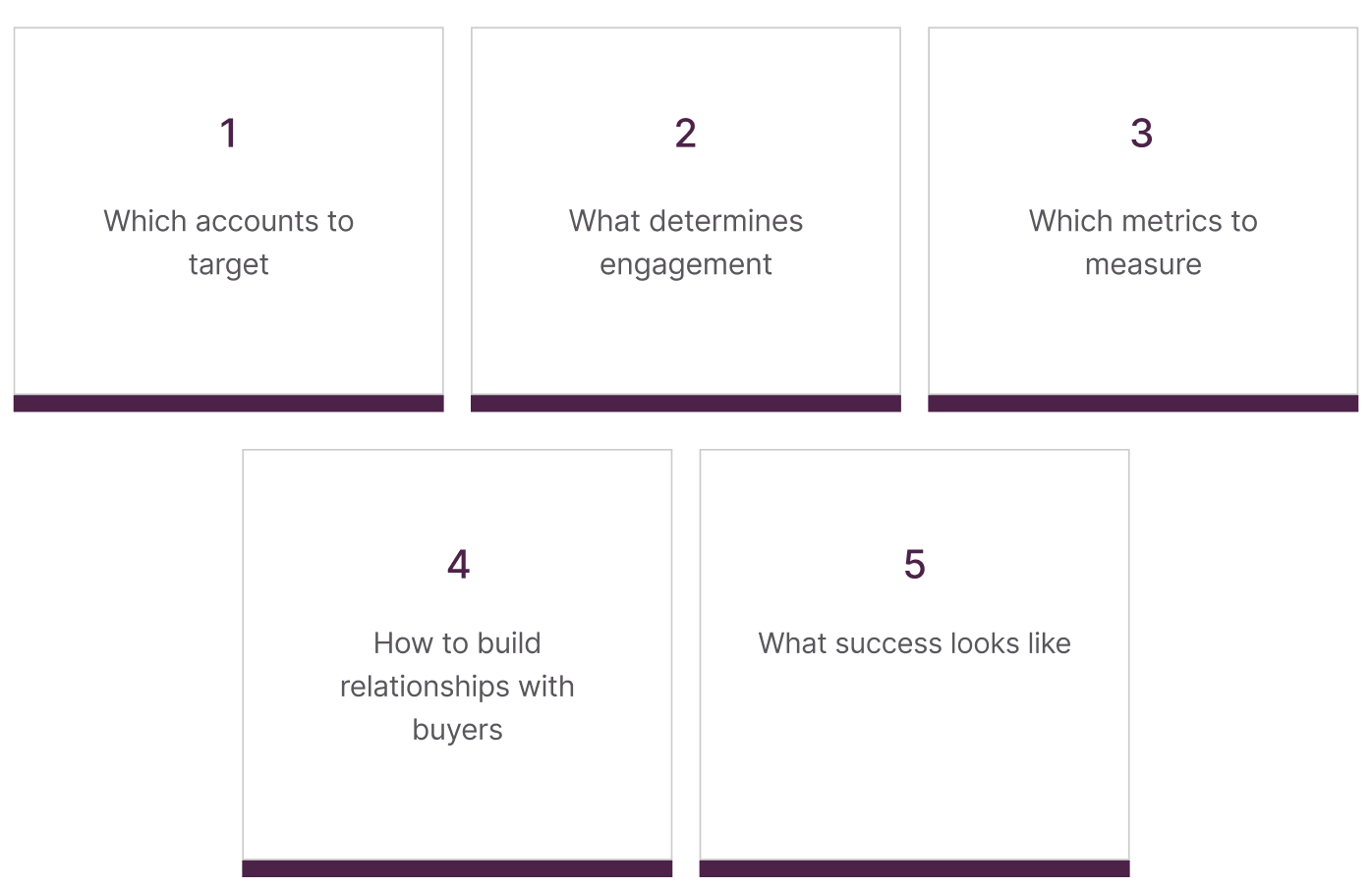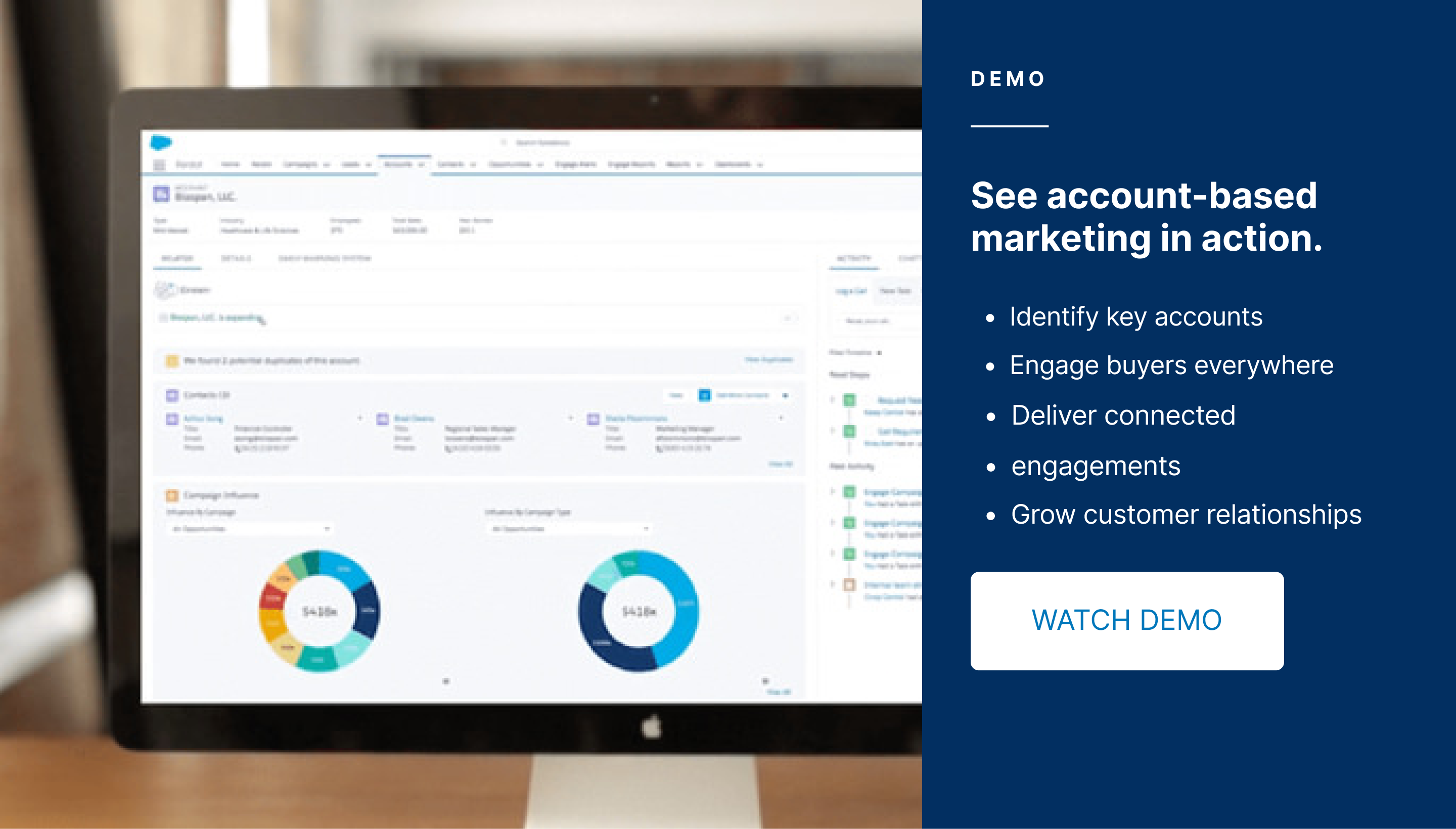Put Your Customers at the Center of Everything You Do
Account-based marketing (ABM) has gotten a lot of buzz among marketing and sales teams — and for good reason. We face a new world with tighter budgets, fewer resources, and sky-high customer expectations. Brands must efficiently engage with customers, optimize performance, and reduce costs — all while making every moment count. Demand for personalized, real-time customer moments is increasing, and B2B marketers need more ways to drive revenue from high-value accounts. The most strategic approach? Aligning marketing, sales, and service teams with an ABM strategy.
What makes ABM so effective? It’s efficient. A cohesive high-touch strategy with marketing, sales, and service helps you more efficiently market to the accounts that matter to your business. And within those accounts, ABM helps you speak to every buyer in a unique and personalized way — building trust and increasing the lifetime value of your customer relationships.

of B2B marketers
have an ABM program. 1

of marketers see higher ROI with
ABM compared to other marketing methods. 2
With the right technology and processes in place, any B2B company — regardless of size, industry or marketing maturity — can implement a successful ABM strategy.
01
What Is Account-Based Marketing?

Account-based marketing is a B2B marketing strategy that focuses on specific customers or accounts. Instead of a single, broad-based campaign with a wide audience, ABM uses multiple highly personalized campaigns to engage accounts with an individualized approach. While it has “marketing” in its name, ABM is not just for marketing teams. ABM involves close alignment across marketing, sales, and service. This close alignment across teams helps you target accounts and ensure a seamless experience — all with a unified message.
As a result, a number of revenue teams are expanding the term to be more inclusive of everyone involved in the strategy. You might also hear terms like "Account-Based Engagement" or "Account-Based Experience," all which showcase how Account-Based Marketing is evolving.
There is no “one size fits all” approach to ABM, and strategies vary based on business goals. Typically, ABM programs fall into one of three buckets: 1-to-1, 1-to-few, and 1-to-many programs.
1-to-1 ABM programs target accounts with high revenue potential. These accounts are going to be where you spend a majority of your ABM budget, time, and energy, but it will be well worth the work based on the potential lifetime value of the customer.
1-to-few ABM programs are a bit broader than the one-to-one programs, but still very targeted. With one-to-few campaigns, the focus should be on narrowing down your account list based on specific criteria that lets you connect with a group of accounts that have similar pain points, buying groups, and business goals.
1-to-many ABM programs identify potentially hundreds of accounts that fall into your target market and also share commonalities across segment, industry, or other relevant criteria. These programs rely heavily on a scaled approach to reach these accounts with a personalized message.
The best ABM strategies:

What do you need to bring an ABM strategy to life? It’ll take a customer relationship management (CRM) solution, combined with a marketing automation platform. Your CRM serves as the single source of truth for data, and powers your account-centric strategy. Your marketing automation platform is critical to engaging target markets at scale and in real time. By unifying this tech stack, all B2B revenue teams can launch and grow an ABM strategy that drives business value and strengthens customer relationships.

Companies that take advantage of ABM’s potential are seeing impressive results.

of ABM users achieve 10% or greater ROI. 3
.png)
of ABM users see at least 2x ROI compared with other
marketing methods. 4
Additional Resources

HOW TO SPEAK ABM: GETTING STARTED WITH ACCOUNT-BASED MARKETING
Tune in to the latest ABM insights, trends, and strategies.
02 
What Does It Mean to
Be “Account-Centric”?
ABM is ultimately about being account-centric, where your buyers are at the center of every interaction. It relies on creating highly personalized, real-time experiences that combine targeted content and intentional communications across every touchpoint.
Today, 62% of buyers expect companies to anticipate their needs, with over half expecting offers to always be personalized. That’s why ABM is designed to interpret and understand buyers on an individual level, so your marketing automatically delivers relevant, personalized content and messages across every channel. For example, when targeting individual buyers based on their role, a CMO would receive one marketing message while a CIO would get another. Aligning marketing, sales, and service teams allows you to equip each team with real-time insights, data, and messages to deliver the right experiences to the right accounts at the right moments.
"Sixty-two percent of buyers expect companies to anticipate their needs."
The key to doing this successfully is your CRM. It’s your single source of truth for account data that gives teams a 360-degree view of the customer and powers account-centric marketing. Next, you can personalize engagements for your audience with marketing automation.
.png)
Identify and Target Accounts
Use real-time data from your CRM and input from your sales team to identify the best ABM target accounts.
.png)
Account Personalization
Create personalized content for target accounts (and personas within those accounts) and distribute it in the ways they prefer.
.png)
Engagement Orchestration
Share leads and adjust tactics across marketing, sales, and service teams based on engagement data.
.png)
Insights and Measurement
To measure the success of campaigns and increase customer retention, track engagement, awareness, and lead-quality metrics.
Additional Resources

HOW TO SPEAK ABM: ACCOUNT ANTHROPOLOGY
Learn how marketers can understand buyers on a deeper level.
03 
How to Identify and Target Your Top Accounts
A successful ABM strategy starts with identifying the right accounts to target. This can include a combination of new and existing accounts. Use your CRM data to identify top accounts that combine potential for high revenue with a strong likelihood of conversion.
Both marketing and sales should be involved in identifying target accounts. They also must maintain open lines of communication for sharing insights and data, such as previous conversion data, account scoring, buying signals from committee members, and look-alike accounts. Once identified, get to know each of these accounts and their buying committees, from understanding the content they prefer and to the channels they use. Your CRM and marketing engagement data will come in handy for this, but you can also search the web and social media to get a nuanced understanding of your target accounts’ particular challenges, priorities, and needs.
However, an intensive study of your accounts can be exhausting and time-consuming. So how can you take the guesswork and analysis out of identifying your top accounts? Try artificial intelligence (AI). Typically, identifying accounts requires marketing, sales, and service teams to sit down and comb through the data. But AI can make this process easier, faster, and efficient — uncovering insights and giving teams a clear rubric as to which accounts are best to engage.
Once you’ve identified the accounts you want to target and developed a 360-degree understanding of their needs and preferences, these accounts can be used as templates to build lookalike audiences for one-to-few or one-to-many ABM programs. This can help you find additional accounts, expand your ideal customer profiles (ICPs), and increase the scope of your ABM plan to include all the best accounts for your business.
Here are some tips to keep in mind as you identify your target accounts:

Additional Resources

HOW TO TARGET THE RIGHT ACCOUNTS AND OTHER ABM INSIGHTS FROM A CMO
This CMO’s ABM strategy won big. See her 3 tips for building yours.

04
Creating Your ABM Toolkit
With the examples and best practices in this chapter, you’ll have the flexibility to deliver custom content across every touchpoint in real time.
Regardless of what tools you use, in order to scale personalized outreach, you’ll want to rely on your demand generation marketing technology. Recent innovations to this technology can now perform scaled personalized outreach much earlier in the marketing funnel. Consequently, demand gen and account-based tactics are converging. As marketers start collecting more first- and zero-party data from their customers, they can pull from firmographic data and buying intent signals when casting their net. The result? Demand gen marketers can be more precise earlier on in the funnel, and thus can build 1-to-few experiences at scale.
This just doesn’t benefit marketing outreach — with the right technology, these insights benefit all teams when they are doing outreach to customers. Sales can tailor conversations based on what content their prospects have downloaded. Marketing can see if a customer has a service ticket in the funnel, and pause communications until it’s resolved. When every team is connected, every team wins.
Explore the tools that can help you enhance your ABM strategy.

.png)
.png)

.png)
.png)

.png)
.png)
05 
Executing Your ABM Strategy
According to the State of Marketing report, 89% of B2B marketers are using an ABM platform to deliver a unified end-to-end experience. And for good reason: when you deliver the personalized experiences your top accounts want, you’ll be more likely to land — and keep — their business.
To execute ABM successfully, you’ll need a high level of coordination between your marketing, sales, and service teams.
All teams need to be aligned on:

ABM brings previously siloed marketing, sales, and service teams together around a single view of the customer. In fact, according to B2B Marketing Trends, top B2B marketing teams are 1.6 times more likely than underperforming teams to collaborate with sales teams on ABM programs.
How to Align All Three Teams
The centralized data required by ABM brings your teams together with a single view of the customer. They’ll be able to take full advantage of intent data, predict when and how to engage a buying committee, and clearly understand the goals and metrics they’re responsible for.
At every level, sales, marketing, and service will need to work together to identify the most high-value accounts, set measurable goals, and track progress as each account moves into the sales funnel.
ABM and Your Industry
Learn essential tips and best practices when building an ABM strategy specific to your industry.

.png)
.png)

.png)
.png)


Additional Resources

RAMP UP YOUR B2B ACCOUNT-BASED MARKETING STRATEGY WITH THIS CRAWL-
WALK-RUN APPROACH
3/4 of marketers report a higher ROI on account-based marketing than any
other marketing effort.

4 WAYS TECHNOLOGY CAN GIVE YOUR ACCOUNT-BASED MARKETING STRATEGY A BOOST
New tech is making ABM more effective. Here are 4 ways to use it.

MARKETING INTELLIGENCE REPORT: DATA, GROWTH, AND THE NEW MARKETING MANDATE
Learn why cross-channel measurement and analytics is essential to your ABM strategy.
06
Salesforce for Account-Based Marketing
Account-based marketing is primarily a marketing strategy. But aligning with sales and service is vital to its success. From identifying your top accounts, engaging buyers, delivering connected engagements, and growing customer relationships, the key to ABM starts with being account-centric and putting your customer at the center of every interaction.
Account-based marketing programs will look different for every company based on their audience and goals, so it’s important to find the perfect mix of solutions to run the right program to reach your audience. Salesforce offers a full range of solutions for companies of all kinds to meet needs of their customers and grow customer relationships with ABM.
With Salesforce, you’ll be able to market to every account, and speak to every buyer.
And they’ll like what they hear.
Getting Started with Marketing and Sales Alignment

Personalize at Scale

Moving to ABM Maturity


Questions?
Request a personalized demo to learn how account-based marketing can transform your business today.


